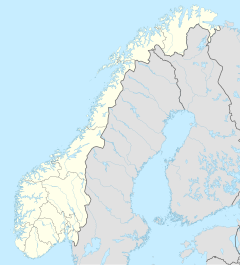Seiland National Park
| Seiland National Park | ||
|---|---|---|
|
|
||
| Location: | Troms og Finnmark , Norway | |
| Next city: | Hammerfest | |
| Surface: | 316.3 km² | |
| Founding: | 12/06/2006 | |
| The national parks in Northern Norway (Seiland has number 27) | ||
The Seiland National Park ( Norwegian Seiland nasjonalpark , North Sami Sievjju álbmotmeahcci ) is a Norwegian national park on the island of Seiland . It belongs to the municipalities of Alta and Hammerfest in the province of Troms og Finnmark . The park was opened on December 8, 2006 in order to preserve and protect the alpine coastal landscape with its unmistakable biological diversity, geological conditions and cultural heritage.
The total area is 316.3 km², whereby the land area is only 306.7 km². The island of Seiland is the second largest island in the former Finnmark province after Sørøya .
Geography, landscape and geology
The landscape in the park is very varied, as the park extends over the fjords and coastal landscapes over the low mountain range on the island and even includes the two glaciers Seilandsjøkelen and Nordmannsjøkelen . The latter are both the two northernmost glaciers in Norway and the lowest glaciers in Scandinavia with 940 moh and 1,040 moh . The highest mountain in the park is the Seilandstuva at 1,079 m .
The two largest fjords are Store Kufjord and Jøfjord , which are located in the south of the island and both run in a north-south direction. In the west, in addition to the glaciers, there are also the highest mountains in the park, which often drop steeply towards the sea. To the southeast of Seilandsjøkelen is a high plateau through which the Melkelva flows.
Flora and fauna
In the southern part of the national park, the soil is very fertile, which is why there is varied vegetation with rare alpine plants such as sandwort , Phippsia algida and arctic poppy .
The steep mountains in the west make for a large population of birds of prey. The most common species are white-tailed eagles , gyrfalcon , merlin , kestrel and buzzard . Along the coastline there are smaller colonies of seagulls , plover-like birds , greylag geese , eider ducks and black guillemots .
The most common mammals are otters , hares and martens . In the summer, numerous reindeer roam the park.
heritage Site
There are cultural relics from different eras and cultures on the island. Finds from the Stone Age and Iron Ages show that the island was settled earlier. Settlement remains were found in almost every fjord arm, some of which could be dated back to 180 AD. To this day, the area in and around the national park is used as pasture for the Sami reindeer in summer.
Tourism and administration
There are some unmarked hiking trails and several overnight huts in the park. There are no roads in the vicinity either, but a ferry from the Akkarfjord , near Hammerfest, to Kjerringholmen in the north of Seiland. A second ferry connection runs from Hammerfest to Øksfjord near Altneset in the south of the island.
See also
literature
- Per Arne Askeland: Drømmelandet. En fotografisk travel i Seiland nasjonalpark. Askeland foto-media, Alta 2007, ISBN 978-82-997698-0-8 .

